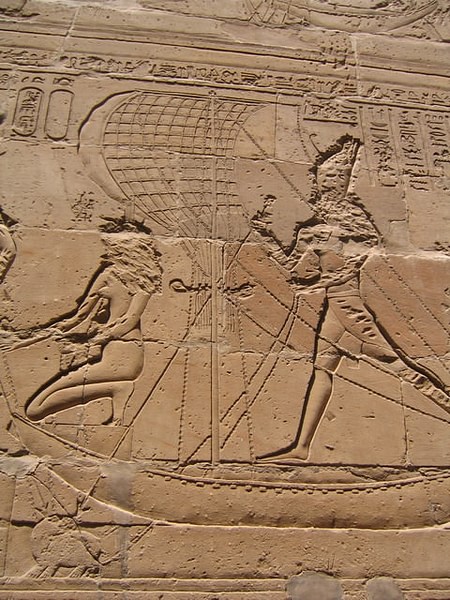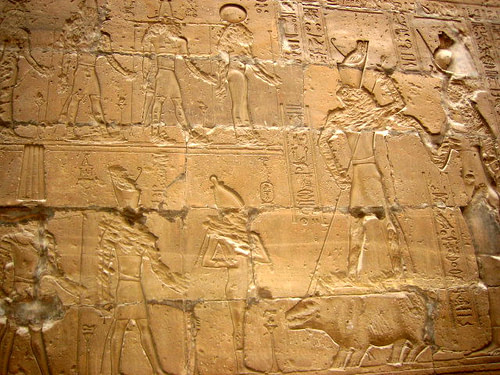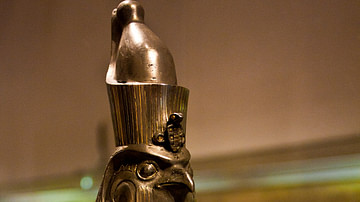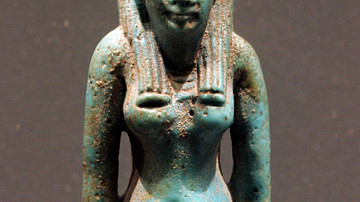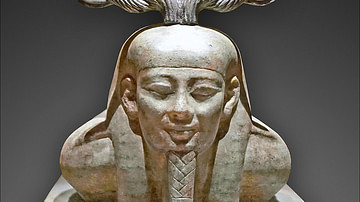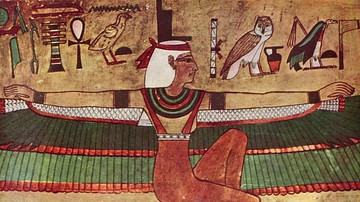
Set, also known as Seth and Suetekh, was the Egyptian god of war, chaos, and storms, brother of Osiris, Isis, and Horus the Elder, uncle to Horus the Younger, and brother-husband to Nephthys. His other consort was the goddess Tawaret, a hippo-headed deity who presided over fertility and childbirth.
He is one of the first five gods created by the union of Geb (earth) and Nut (sky) after the creation of the world. His name is usually translated as "instigator of confusion" and "destroyer" and he was associated with disorder, foreign lands and people, and the color red.
He is sometimes depicted as a red-haired beast with a forked tail and cloven hooves or a shaggy red dog-like beast known as a sha (or, to modern-day scholars, as the Set Animal) which some scholars claim was modeled on the Saluki breed while others maintain was a purely mythological creature imagined specifically to represent Set whose other symbols were the griffin, hippopotamus, crocodile, and tortoise (though he was primarily associated with the serpent). His epithets include "Lord of the Desert" and "Ruler of the South" as he was originally a god of Upper Egypt (the south) and the barren lands beyond Egypt's borders.
In the Early Dynastic Period of Egypt (c. 3150 - c. 2613 BCE) he was an important - and benevolent - god of Upper Egypt whose name was invoked for love spells and inscribed on amulets which served as love charms. He was also the deity who saved the sun god Ra from the serpent Apophis, an evil creature who tried to stop the sun god's journey through the night sky toward dawn. Egyptologist Richard H. Wilkinson comments on this myth and Set's role as hero, writing:
It was said that each night Apophis hypnotized Ra and the entourage who sail with him except for the god Seth who resisted the serpent's deadly stare and repulsed him with the thrust of a great spear. (221)
In doing so, Set assured that the sun would rise the next morning. Set was also seen as a benefactor who helped the people in life and provided for them after death, but by the time of the New Kingdom (c. 1570-c. 1069 BCE) he came to be best known as the first murderer, who killed his older brother Osiris to reign over the world and then tried to murder Osiris' son Horus.
To the Greeks, he was associated with Typhon, the god-monster who challenged the might of Zeus and was hurled into Tartarus. Precisely why Set's attributes and image changed from a hero-god to the enemy of order and justice is unknown, but by the time the Osiris myth became popular during the New Kingdom, Set's transformation was complete. He was still invoked by common people and pharaohs for assistance, however, and his name is evident of that of rulers such as Seti I, Sethnakhte, and Seti II.
Although his wife was his sister Nepthys, he was associated with foreign goddesses such as the warrior-goddess Anat from Ugarit in Syria, and Astarte, the Queen of Heaven, from Phoenicia. It is thought that he represented the dry and barren desert lands and distant territories outside of Egypt as contrasted with Osiris and Horus who symbolized the fertility of the Nile River Valley.
Mythical Origins & the Murder of Osiris
The first five gods of Egypt were born of the union of the brother and sister gods Geb (earth) and Nut (sky) after the creation of the world by Atum. Osiris was the first-born, then Isis, Set, Nephthys and Horus (known as Horus the Elder). As first-born, Osiris was elevated as ruler of the world which, to the Egyptians, meant the land of Egypt. Osiris found the newly-created people to be barbarous and uncivilized and so gave them culture, taught them agriculture, provided them with laws, and instructed them in the proper ways to worship the gods. Osiris took his sister Isis as his wife, and she bestowed on humans her gifts of compassion and equality for all. The world was a paradise where everyone, man and woman, was equal under the reign of the royal couple, food was abundant, and no one suffered any want.
Set grew jealous of Osiris' power and resented his success. His resentment grew more bitter after his wife Nephthys, attracted by Osiris' beauty, disguised herself as Isis and seduced the great king, becoming pregnant with the god Anubis.
Set decided to remove his brother and had a magnificent casket created, the most beautiful chest ever made, tailored to Osiris' exact measurements. He threw a grand party, to which Osiris was invited, and after the banquet told the guests he had a special surprise. He revealed the chest and said that whoever could fit most perfectly inside could take it home. One by one the guests climbed into the casket but could not fit until Osiris' turn came. He lay down in the casket and found, of course, that it fit him perfectly. Set then slammed the lid on and threw the casket into the Nile River.
In some versions of the story, Osiris is murdered by Set and 72 accomplices while in others he alone is responsible. A further variation is that sometimes Set is said to have murdered Osiris in the casket and then disposed of it while in other versions Osiris suffocates once he is thrown into the river or after the casket is encased by the tree at Byblos.
The casket with Osiris' body inside floated down the Nile and out to sea, finally coming to the shores of Byblos in Phoenicia, where it lodged in a tamarisk tree. The tree grew quickly around it, encasing it, and Osiris was lost to the people of Egypt. In time, the king and queen of Byblos came to the shore and noticed the beauty of the tree and its sweet scent and had it cut down and brought to their court as a central pillar. Back in Egypt, Set took the throne, and the harmonious balance which had been maintained by Osiris and Isis was lost. Set was a chaotic and unpredictable monarch who brought storms and drought and the people turned on each other in their efforts to survive.
Isis & Osiris' Rebirth
Isis went in search of her missing husband and finally came to Byblos where she endeared herself to the king and queen and became nursemaid to their young sons. As usual when Isis walked among human beings, she was disguised as an elder woman and no one at court knew they were dealing with a goddess. Isis became fond of the younger son, Dictys, and tried to make him immortal by burning away his mortal qualities in a magical fire. One night, when the queen interrupted Isis at this work, she was horrified and screamed, startling Isis who threw off her disguise and revealed her true identity. The king and queen were terrified and promised her anything she wanted if she would only spare them. Isis asked for the tamarisk pillar, which they quickly gave her.
She freed Osiris from the tree and brought him back to Egypt, where she hid his body in the swampy marshes of the Nile Delta while she went off to gather herbs to revive him. Worried that Set might discover the body, she asked her sister Nephthys to keep watch. Set, in the meantime, heard that Osiris had returned to Egypt and went searching for him. He found Nephthys and tricked her into revealing where the body was hidden. Set then hacked the body into pieces and flung the parts all across the land and into the river. When Isis returned with her herbs, a tearful Nepthys told her what had happened, and together they went looking for the body parts to reassemble them.
Once Isis had put Osiris back together, she found he was incomplete. His penis had been eaten by the oxyrhyncus fish and could not be retrieved. Isis was still able to return her husband to life but, since Osiris was incomplete, he could no longer rule over the living and would have to descend to the underworld. Isis transformed herself into a kite (a falcon) and flew around his body, drawing his seed into her body and becoming pregnant with the god Horus (sometimes referred to as Horus the Younger). Osiris then went to the underworld where he became Lord of the Dead and the judge of souls.
The Contendings of Horus & Set
An Egyptian manuscript from the 20th Dynasty (1190-1077 BCE) tells the much older story of the battle for control of the world between Horus, son of Osiris, and his uncle Set. The story, known as The Contendings of Horus and Set, is the account of the legal battle before the gods over who is the rightful king of Egypt. Horus and Set both present their cases and then must prove themselves in a series of contests and battles which are all won by Horus who, in the end, is proclaimed king.
The Contendings of Horus and Set is only one version of what happened after Horus was born and Osiris descended to the underworld. Other myths describe how Isis hid her child from Set in the swamps of the Nile Delta as Set searched for the boy to murder him. The popular tale of Isis and the Seven Scorpions is set during this time and depicts Isis going out at night to local towns to beg for food for herself and her son. There are other stories and legends concerning Horus' youth and Isis' care for him, and when he had matured he challenged his uncle for the throne.
In some versions of the story, Horus battles Set, defeats him, and drives him from the land, while in others Set is killed. The Contendings of Horus and Set depicts these battles as contests ordered by the gods. The majority of the nine gods (known as the Ennead) presiding decided that Horus was the rightful king but Ra, the sun god was not convinced, and the decision had to be unanimous. Ra believed that Horus was too young and had led too sheltered a life to effectively rule while Set had proven himself a capable, if uneven, monarch. Even though Horus won every contest against his uncle, Ra would not be moved. This trial went on for over 80 years while the people of Egypt suffered under Set's chaotic reign.
Isis understood that she would have to intervene for the good of the people and so transformed herself into a young woman and sat down outside of Set's palace where he would have to pass by her. She cried and cried until her cheeks were red and streaked with tears when Set, walking by, saw her and asked what the matter was.
She told him how a wicked man, her husband's own brother, had murdered him and taken his land and flocks, and how she and her son had been driven from their inheritance, and further how the evil man now even sought her son's life. Set was deeply moved by her story and became enraged. He swore that he himself would destroy the criminal and restore the land to the poor woman and her son. Isis then revealed herself and the presence of the listening gods. Ra was convinced at last that Horus should rule, and Set was driven from the Nile Valley to the desert wastelands.
Horus then became king of the world with Isis as his consort and ruled wisely as his father had before him. Order was restored to the land, and the equality of the people was renewed. The Nile River again overflowed its banks, sent by the mercy of Osiris, and the land became fertile again, and the crops were again abundant. Horus followed his father's example in all things and continued those practices of kingship and stewardship of the land which the mortal kings of Egypt would hold as their standards and incorporate as their values.
In another version of The Contendings of Horus and Set, the gods cannot come to agreement and consult the goddess Neith. Neith was very wise and often called on to mediate disputes between the gods. She suggested that Horus be given rule of Egypt and Set free reign of the desert regions and foreign lands. Recognizing that no land could equal the splendor of Egypt, she also suggested the Ennead grant Set the foreign goddesses Anat and Astarte as consorts as a kind of consolation. This version of the story may predate the tale of Isis resolving the contention as Neith was an ancient goddess, very popular in the Predynastic Period, whose attributes were later absorbed by Isis.
The Transformation of Set
From the New Kingdom onward, Set was regarded as the villain according to the above myth (with different variations) but, as noted, was not always so. In the Early Dynastic Period, Peribsen, the sixth king of the Second Dynasty (c. 2890 - c. 2670 BCE) chose Set, rather than Horus, as his patron god. Osiris was seen as the first king but, following his death and resurrection, was no longer lord of the earth. Horus, as his rightful heir, held that title, and so Egyptian kings from the Early Dynastic Period onward, identified themselves with Horus and claimed the protection of Isis as representatives of her son on earth. When the pharaoh died, then he was identified with Osiris in the realm of the dead.
It is quite interesting, then, that Peribsen should have chosen to align himself with Set rather than Horus. Although the story of Set's murder of Osiris does not gain full momentum until later in history, Osiris' name and an early version of the story appears in the Fifth Dynasty (2498-2345 BCE) and it is thought this story is even older. Peribsen is the only king of the Early Dynastic Period to separate himself from Horus and align with Set, and although many theories have been proposed, none is completely satisfactory.
Since it is known that Set was originally a hero-god, it makes sense that a king would choose him as patron, but by the time of Peribsen, Horus was linked to the monarch, not Set. The second king of the Second Dynasty, Raneb, was the first ruler to link the monarchy of Egypt to the gods by associating his name with the sun god Ra, and Ra was associated with Horus. Ra was also associated with Set, however, as it was Set who, in early stories, protected Ra from Apophis when the god traveled the night skies. This story could have been so popular at the time that Peribsen's alignment with Set would pose no mystery, but this still does not explain the departure from identification with Horus.
Another theory is that Peribsen was the first monotheist in Egypt, predating Akhenaten (r. 1353-1336 BCE) by centuries, but this has been disproved by evidence of the worship of many gods during Peribsen's reign. The most likely theory, though by no means certain, is that Peribsen, of Upper Egypt, chose Set as his personal protector to distance himself from Horus who seems to have been identified with Lower Egypt at the time.
All evidence of Peribsen's reign comes from Upper Egypt, and he is not mentioned in the inscriptions of Lower Egypt from the period. The Second Dynasty is among the more obscure, owing to a significant lack of records from the time and confusion among those which do exist. Peribsen is the only king to so clearly identify himself with Set until the 19th Dynasty under Seti I (r. 1290-1279 BCE) and his son Ramesses II (r. 1279-1213 BCE) who made Set a national god and honored him with a temple in the capital, the Sepermeru, where his wife Nephthys was also worshiped.
The Role of Set
By the time of Ramesses II, the Osiris myth was well known and Set had been transformed from a god of love, protector, and hero into the villain who stood for everything the Egyptians feared and hated: disorder, chaos, waste, drought, famine, destruction, hunger, and foreign invasion/influence. He must still have had some resonant associations with his former role as a protector god for Ramesses II to have elevated him to such a degree, but the cult of Osiris and Isis was so widespread by this time it is difficult to understand how.
Worship of Set and Horus had developed from the time of Peribsen so that, by Ramesses II's time, Horus was associated with Lower Egypt (the north) and Set with Upper Egypt (the south) and inscriptions of the crowning of the king would show both Set and Horus officiating at the regnal ceremony. In time, however, Set became so closely identified as the villainous murderer and usurper that he was replaced in these inscriptions by Thoth, god of writing and wisdom.
The enduring popularity of Set is most probably due to the Egyptian's appreciation of balance and harmony. The concept of ma'at (harmony) was integral to Egyptian values and featured even in their understanding of the afterlife where the heart of the deceased was weighed in the balance against the white feather of ma'at. Osiris, as god of fertility and life, required a counter in the form of Set as god of destruction and chaos. Even in this role, Set was considered sometimes beneficial as he voluntarily held back his desert forces of dry winds and drought from the fertile lands of Egypt. Prayers to Set for protection from, essentially, himself replaced the earlier amulets relating to love.
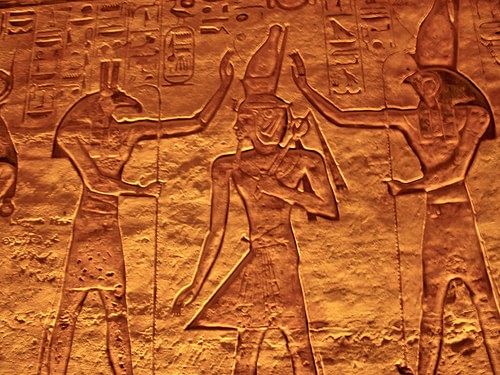
Set was worshiped primarily at his cult center in the city of Ombos from at least the Early Dynastic Period but had temples honoring him throughout the land. As with other gods, the priests of Set took care of his statue, which no one else could draw near to, in the inner sanctum of the temple and also were responsible for daily rituals and upkeep of the temple complex.
People petitioning the god for help were only allowed in the outer courtyards of temples, never in the sanctuary, where they would leave their donations or make requests of the priests for help in their lives - which could range from anything from marital advice to counseling to medical or financial assistance and, of course, officiations at funerals, weddings, or festivals.
Like many aspects of the Osiris myth, Set was incorporated into the early mythology of Christianity as the devil (the serpent Apophis has also been suggested as contributing to this figure's development). Set's relationship to darkness and wickedness, as well as the color red and the popular image of him as a red-haired beast, all leant themselves to the iconography of the Christian Satan. Like Satan, he brought about the end of paradise and was cast out of the land of the gods for rebelling against harmonious rule. His association with deceit, cunning, war, destruction and close connection with the serpent also worked well in fashioning the Christian concept of the great supernatural deceiver of human beings, who swore eternal enmity with God.
In the gospels of Matthew, Mark, and Luke, Jesus is tempted by Satan in the desert (or, in Matthew, in "the wilderness"), and the earlier figure of Set was strongly associated with deserts and the unknown lands beyond Egypt's borders (see Matthew 4:1-11, Mark 1: 12-13, and Luke 4:1-13). Set continued to play the role he had been given by the Osiris myth in a whole new context and belief system: as the deceiver and adversary of human beings, responsible for their suffering in a world originally created as a paradise.
